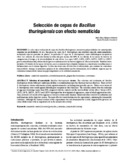| dc.contributor.author | Márquez Gutiérrez, María Elena | |
| dc.contributor.author | Fernández Gonzálvez, Emilio | |
| dc.date.accessioned | 2015-03-19T22:08:44Z | |
| dc.date.available | 2015-03-19T22:08:44Z | |
| dc.date.issued | 2006 | |
| dc.identifier | 471599 | es_ES |
| dc.identifier.issn | 1659-0082 | es_ES |
| dc.identifier.uri | https://repositorio.catie.ac.cr/handle/11554/6798 | |
| dc.description | 1 ilustración, 2 tabulaciones, 34 referencias | es_ES |
| dc.description.abstract | La selección y evaluación de cepas de Bacillus thuringiensis con nuevas potencialidades de control podría aumentar sus posibilidades de uso. Son pocas las cepas de B. thuringiensis con actividad conocida contra nematodos, incluyendo especies parásitas de plantas. Se probaron 37 cepas de B. thuringiensis contra Meloidogyne incognita in vitro. Los criterios de selección fueron la reducción por encima del 80% de la eclosión de las masas de huevos en comparación al testigo, y la irreversibilidad de este efecto. Las cepas LBT1, LBT3, LBT4, LBT24, LBT25 y LBT47 provocaron deformación y detención del proceso embrionario de los huevos algunos de ellos necrotizados. También varios juveniles (J2) dentro de las masas de huevos, no reaccionaron bajo estímulos luminosos, y mostraron vacuolizaciones y deformaciones en el sistema digestivo. La fracción tóxica más efectiva fue el sobrenadante, que contiene las exotoxinas termoestables. Aunque la naturaleza química de los sobrenadantes no fue determinada, los resultados sugieren que las exotoxinas termoestables tienen un papel importante en la actividad nematicida. | es_ES |
| dc.description.abstract | The selection and evaluation of Bacillus thuringiensis strains with new control possibilities is an international practice that may increase their use. There are few B. thuringiensis strains with known activity against nematodes, including plant parasitic species. Thirty-seven strains of B. thuringiensis were tested against Meloidogyne incognita in vitro bioassays. The selection criteria were the reduction of egg mass hatchings (more than 80% compared with the control) and the irreversibility of this effect. Strains LBT1, LBT3, LBT4, LBT24, LBT25 and LBT47 interrupted the development of egg masses, some of which appeared necrotic. Some juveniles (J2) inside of the egg masses had no reaction under luminic stimuli and others showed vacuolization and malformations in the digestive system. The most effective toxin fraction was the supernatant, containing the termostable exotoxins. Although the chemical nature of the supernatants was not determined the results suggested the presence of extracellular toxins with an important role in the nematicidal activity. | en_EN |
| dc.format.mimetype | pdf | |
| dc.language.iso | es | es |
| dc.publisher | CATIE, Turrialba (Costa Rica) | es_ES |
| dc.relation.ispartof | Manejo Integrado de Plagas y Agroecología Número 78 (Agosto 2006) | |
| dc.rights.uri | https://creativecommons.org/licenses/by-nc-nd/4.0/ | |
| dc.subject | BACILLUS THURINGIENSIS | es_ES |
| dc.subject | MELOIDOGYNE INCOGNITA | es_ES |
| dc.subject | NEMATODA | es_ES |
| dc.subject | MELOIDOGYNE | es_ES |
| dc.subject | NEMATODOS DE LAS PLANTAS | es_ES |
| dc.subject | CONTROL DE NEMATODOS | es_ES |
| dc.subject | NEMATOCIDAS | es_ES |
| dc.subject | PLAGUICIDAS BACTERIANOS | es_ES |
| dc.subject | BACTERIA | es_ES |
| dc.subject | EXOTOXINAS | es_ES |
| dc.title | Selección de cepas de Bacillus thuringiensis con efecto nematicida | es_ES |
| dc.title.alternative | Selection of nematicide Bacillus thuringiensis strains | es_ES |
| dc.type | Artículo | es_ES |
| dc.journal.issueNumber | 78 | |
| dc.journal.pages | 63-69 | |



